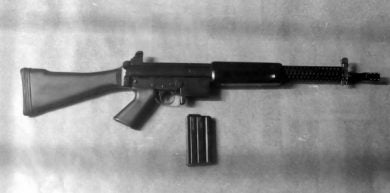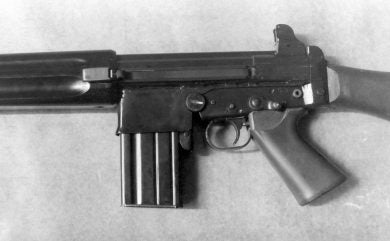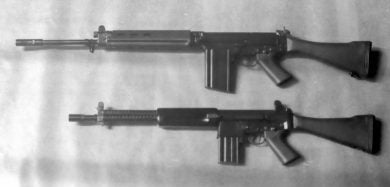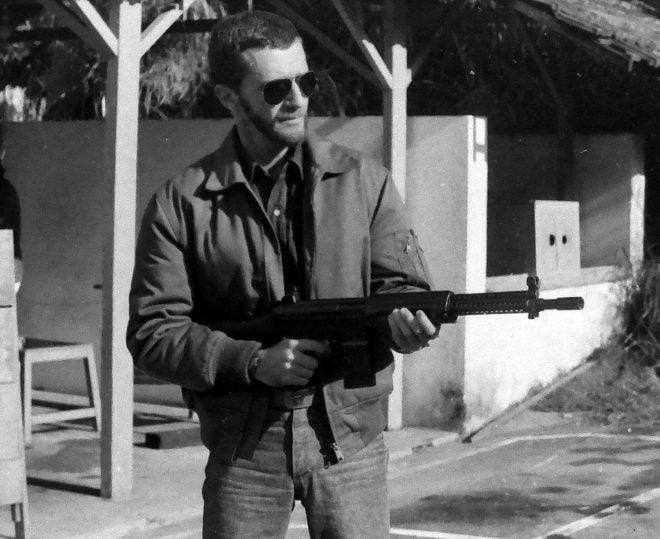Prior to having its 5.56x45mm IA2 rifle developed, field-tested, approved and officially adopted (2011-2015 period, approximately) by the Exército Brasileiro (Brazilian Army), IMBEL – Indústria de Material Bélico do Brasil took a long way to cover this evolutionary path. The whole thing can be traced back to the mid-1930s, when the Army’s Fábrica de Itajubá (Itajubá Factory), in Minas Gerais State, started the local manufacture of the 7x57mm Mauser M1908/34, a 200mm shorter variant of the omnipresent 1908 model. While fighting alongside U.S. troops in the Italian Front in WWII, however, troops of the FEB (Força Expedicionária Brasileira, Brazilian Expeditionary Force) were armed with M1903 Springfields and M1 Garands, plus M1918 BARs and Browning M1917/M1919 machine guns.
Following that conflict, the Army not only kept all those weapons for general use, but colossal supplies of .30-06 ammunition as well. This prompted it to decide to abandon the older 7x57mm cartridge as its standard round. Local rifle production followed suit, and Fábrica de Itajubá soon introduced its Mq.30 M1949 and a later Mq.30 M1950 Mauser-derived bolt-action rifles, both chambered to the U.S. cartridge.
The official adoption of the 7.62x51mm round by NATO in 1954 resulted, ten years later, in the Brazilian Army also changing to the new round and adopting the FN FAL as its standard rifle, series license production starting at the Itajubá factory in August, 1964. Full nationalization of the locally-designated Fz 7,62 M964 (fixed stock) and Fz 7,62 M964A1 (foldable stock, the Para-FAL) was achieved in 1973. IMBEL was officially created on May 5, 1977, with the subsequent incorporation of Fábrica de Itajubá as Filial Número 5 (Number 5 Branch).
It was only a matter of time until the 5.56x45mm round started being considered for future Brazilian Army use, as the cartridge had been officially adopted by the Força Aérea Brasileira (Brazilian Air Force) in the very early-1970s for a substantial acquisition of Heckler & Koch HK33s in rifle and carbine configurations.

The Fz 5,56 IMBEL MD1 employed some FAL components, but the breech locking system was different.
The first move towards a Fábrica de Itajubá-made 5.56x45mm rifle came to light in mid-1983 with the prototype of a selective-fire rifle chambered to that round, the Fz 5,56 IMBEL MD1, designed and built at that facility’s Oficina de Protótipos (Prototypes Workshop). Not surprisingly, it incorporated more than a few FAL components, the fixed synthetic stock and the trigger/grip group being the more evident. However, the gas-operated piston system departed from the Belgian gun’s tilting breechblock components, which gave place to a rotary bolt with multiple locking lugs, the 20-round steel magazine being a proprietary type.

Right side view of the single prototype built with the proprietary 20-round magazine removed.
The rifle featured a somewhat redesigned lower receiver fitted with a stamped magazine housing, as well as a perforated jacket that involved both the gas tube and part of the 464mm-long barrel, which was fitted with a NATO-standard 22mm flash hider. Loaded weight was about 4kg, heavy all right, but weight reduction along the development phase was a goal of the small, enthusiastic design team.

This closer view shows a number of FAL components used, mainly in the pistol grip/trigger/fire selector area. Also note the lie-flat cocking handle and the large push-forward magazine catch.
I had a chance to fire that single prototype in June 1983, and pretty much liked how it handled and worked. Its moderate cyclic rate of fire of about 700 rounds per minute plus the relatively high weight (for the caliber at hand) was a bonus when it came to controllability in the full-auto mode.

Author snaps magazine into place during informal firings of the prototype at a factory range back in 1983.

A perforated metal jacket, just ahead of the wooden handguard, covered both the gas tube and part of the barrel.
It should be pointed out that the initial development of this weapon was not the effect of a Brazilian Army clear intention toward that, but the result of an in-house study that showed that 5.56x45mm was the inescapable trend. But official interest did eventually show up in 1986, when a Brazilian Army Staff document called Objetivos Básicos Operacionais 39/86 (Basic Operational Objectives 39/86) was issued. It stated that a rifle in that caliber would be needed as the basic weapon for the 1 Batalhão de Operações Especiais (1st Special Operations Battalion) that had been created three years earlier. However, the unit’s reduced size of about 600 men at that time would not justify the considerable R&D costs involved in creating an entirely new weapon, so it was decided to save development time and costs by making the basic FAL in 5.56x45mm, instead.

Side by side with a 7.62x51mm Fz M964, the Fz 5,56 MD1 shows evident family ties.
The subsequent steps were not exactly successful, but this will be covered by TFB in the future.
 Your Privacy Choices
Your Privacy Choices
